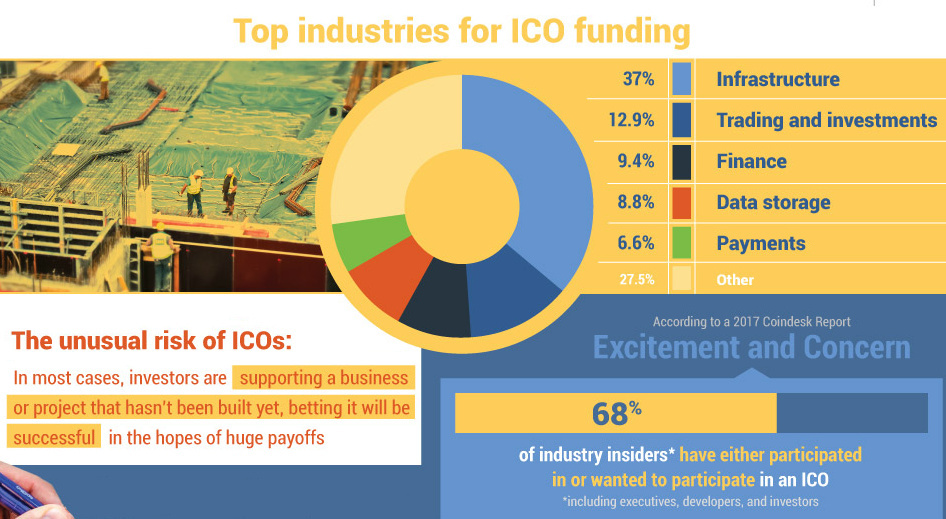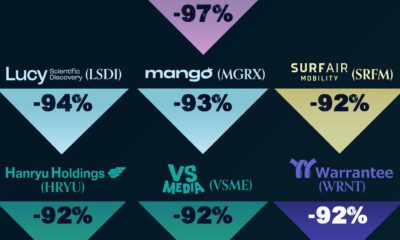Technology
Visualizing the Rise of the ICO

Visualizing the Rise of the ICO
If you ask any investor about Initial Public Offerings (IPOs), you’re not likely to get an extreme range of opinions.
That’s because IPOs have been around for centuries, they’re heavily regulated, and they usually are reserved for companies with impressive traction as they transition to the public market through a storied exchange like the NYSE or Nasdaq.
During times of extreme market froth, like the Dotcom bubble, a newly public company can be the subject of intense amounts of speculation. However, in relative terms, most IPOs are fairly benign.
Companies going public simply have a very abbreviated track record, which makes them difficult to value by the market.
Introducing the ICO
Today’s infographic comes to us from Coinlist, and it showcases the long-lost cousin of the IPO: the initial coin offering (ICO).
At the most basic level, an ICO is a crowdfunded offering of a newly issued cryptocurrency that can be used as a source of capital for startup companies. Investors buy these coins or tokens with legal tender or through the exchange of other cryptocurrencies such as Bitcoin or Ethereum.
And ICOs have taken off – see the incredible video on the explosion in ICOs for yourself.
ICO vs. IPO
Here are some major differences between ICOs and IPOs.
Risk
For a newly-listed public company, the market has limited information to assess – but usually the company has some known traction: sales, revenue, growth, etc. New listings can still be risky, but most still have some intrinsic value, even if that is just an asset at book value.
ICOs, on the other hand, are usually used to raise capital for a new idea or technology. Ethereum, which ICO’d in 2015, is a blockchain-based technology that focuses on enabling smart contracts and decentralized apps. While it wasn’t “proven” at the time of its ICO, Ethereum is now a wild success.
The only problem: not all new technologies or ideas are proven, and some will certainly crash and burn. Further, some will even be scams. Thus, the level of potential risk with ICOs cannot be understated.
Regulation
Newly-listed companies are highly regulated, for better or worse.
ICOs are not regulated, though the SEC has stated that it will treat ICOs as security offerings in some situations. Meanwhile, other countries like South Korea and China have banned ICOs altogether, at least temporarily.
Democratization
While early-stage venture capital and IPOs are traditionally much more difficult for the average person to get exposure to, anyone can buy into an ICO.
In this sense, the ICO offers something similar to crowdfunding: the ability for projects to raise money from a strong community of regular people. This community-based approach can also enable non-profit ventures to succeed.
A Full List of Pros/Cons
For a much more in-depth list of the pros and cons of ICOs, this article by Outlier Ventures provides some fantastic insights.
Brands
How Tech Logos Have Evolved Over Time
From complete overhauls to more subtle tweaks, these tech logos have had quite a journey. Featuring: Google, Apple, and more.

How Tech Logos Have Evolved Over Time
This was originally posted on our Voronoi app. Download the app for free on iOS or Android and discover incredible data-driven charts from a variety of trusted sources.
One would be hard-pressed to find a company that has never changed its logo. Granted, some brands—like Rolex, IBM, and Coca-Cola—tend to just have more minimalistic updates. But other companies undergo an entire identity change, thus necessitating a full overhaul.
In this graphic, we visualized the evolution of prominent tech companies’ logos over time. All of these brands ranked highly in a Q1 2024 YouGov study of America’s most famous tech brands. The logo changes are sourced from 1000logos.net.
How Many Times Has Google Changed Its Logo?
Google and Facebook share a 98% fame rating according to YouGov. But while Facebook’s rise was captured in The Social Network (2010), Google’s history tends to be a little less lionized in popular culture.
For example, Google was initially called “Backrub” because it analyzed “back links” to understand how important a website was. Since its founding, Google has undergone eight logo changes, finally settling on its current one in 2015.
| Company | Number of Logo Changes |
|---|---|
| 8 | |
| HP | 8 |
| Amazon | 6 |
| Microsoft | 6 |
| Samsung | 6 |
| Apple | 5* |
Note: *Includes color changes. Source: 1000Logos.net
Another fun origin story is Microsoft, which started off as Traf-O-Data, a traffic counter reading company that generated reports for traffic engineers. By 1975, the company was renamed. But it wasn’t until 2012 that Microsoft put the iconic Windows logo—still the most popular desktop operating system—alongside its name.
And then there’s Samsung, which started as a grocery trading store in 1938. Its pivot to electronics started in the 1970s with black and white television sets. For 55 years, the company kept some form of stars from its first logo, until 1993, when the iconic encircled blue Samsung logo debuted.
Finally, Apple’s first logo in 1976 featured Isaac Newton reading under a tree—moments before an apple fell on his head. Two years later, the iconic bitten apple logo would be designed at Steve Jobs’ behest, and it would take another two decades for it to go monochrome.
-

 Travel1 week ago
Travel1 week agoAirline Incidents: How Do Boeing and Airbus Compare?
-

 Markets3 weeks ago
Markets3 weeks agoVisualizing America’s Shortage of Affordable Homes
-

 Green2 weeks ago
Green2 weeks agoRanked: Top Countries by Total Forest Loss Since 2001
-

 Money2 weeks ago
Money2 weeks agoWhere Does One U.S. Tax Dollar Go?
-

 Misc2 weeks ago
Misc2 weeks agoAlmost Every EV Stock is Down After Q1 2024
-

 AI2 weeks ago
AI2 weeks agoThe Stock Performance of U.S. Chipmakers So Far in 2024
-

 Markets2 weeks ago
Markets2 weeks agoCharted: Big Four Market Share by S&P 500 Audits
-

 Real Estate2 weeks ago
Real Estate2 weeks agoRanked: The Most Valuable Housing Markets in America















